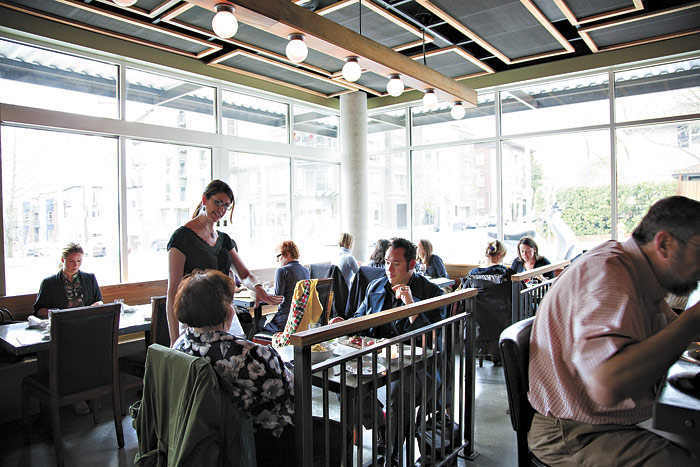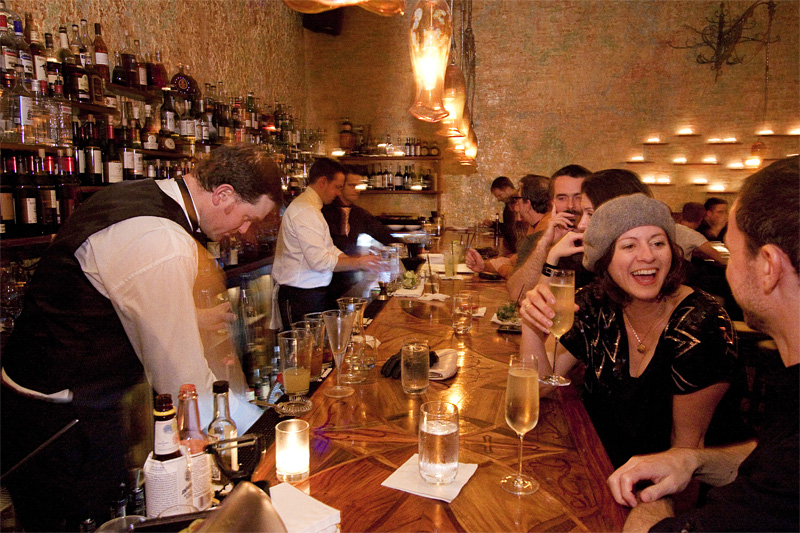The only way to remain on top of the bestseller lists is to settle on a formula and master it. Look at Elmore Leonard, 83 and on his 46th novel. Leonard sets up an A plot with a principled con facing a ludicrous challenge and a B plot involving an insane/amoral criminal (C and D plots, too—it’s not a simple formula), then sets them all zigzagging toward one another to meet in some I-can’t-believe-this-is-happening climax.
‘Round about his third restaurant (Queen Anne’s How to Cook a Wolf), best-selling chef Ethan Stowell found his formula. He would focus mainly on shared small plates, complemented by a half-dozen pastas made centrally in the Tavolata kitchens, and perhaps a handful of entrées. Stowell’s dishes highlight whatever’s on the market, supplemented by ingredients food geeks have just read about in Food & Wine, all prepared and presented in straight-up fashion.
“This is like every other Ethan Stowell restaurant, only with seafood,” commented a friend as we ate our first meal at Anchovies & Olives, restaurant #4 of the burgeoning Stowell empire. Mind you, that was not meant as a dismissal. When reading Leonard, you know the story’s going to end up in a wry comeuppance for the hero and a satisfyingly grisly end for the villain. The pleasure’s in the nimble mechanics of the plot and the screwy characters. Likewise, at Stowell’s restaurants, you know that your check is going to be big but not outlandish, that a couple of the dishes on the table will be too simple for their own good, and the rest will be so amazing that you’ll be missing them before you’ve finished your last bite.
The one I’m still thinking of, more than a month later: two grilled mackerel fillets laid over a pile of shredded radicchio and hen-of-the-woods mushrooms. Stowell combines fish and mushrooms often (his veggie-friendlier twist on the surf-and-turf), and it always comes out right. The mackerel, whose oily flesh was so fresh that it tasted butter-basted; the meat of the mushrooms; the bitter shocks of the greens; the deep tang of a good aged balsamic drizzled over top—the dish was potent with the richness of spring, like the first time you flop down on a patch of grass and smell the loam reawakening.
If there’s one element that distinguishes Anchovies & Olives from its precursors, it’s the blandness of the decor. Tavolata and How to Cook a Wolf have such distinctive designs—the first a loft in Danzig, the second a Norwegian linen closet—that they enfold you in their ambience. But Anchovies & Olives feels like a generic retail space in a generic, brand-new condo complex (which it is). There’s an open-to-the-public cooking line, which looks like a demonstration kitchen at Sur la Table. There’s a bar, but it has no shelves and no mirror, just a row of bottles and a row of stools. The walls have no artwork, and the bathroom isn’t much posher than my own. One of my friends thinks A&O will be the perfect restaurant for July, since two of its four walls are story-high windows, but the view of parking lots and empty units in the condo across the street isn’t particularly summery.
But if the style feels tossed off, the food and service do not. This is the third Stowell restaurant co-run by Patric Gabre-Kidan, who first signed up with the Union chef when he launched Tavolata in 2007. So they’re not starting off with a green crew. Many of the front-of-house staff cycle in from their other restaurants. Months ago, Stowell hired Charles Walpole—a longtime #2 chef at Mistral—to be head chef at Anchovies & Olives. But first he had him work the line at How to Cook a Wolf and Union until he learned Stowell’s style.
The other reason Anchovies & Olives has opened strong is Stowell and Gabre-Kidan’s gift for picking the right time and location. Sited on the edge of Capitol Hill’s new 12th Ave. gourmet ghetto, walking distance for Pike/Pine-goers and Madison Valley residents, Anchovies & Olives is bound to become a drop-in spot not just for full dinners but for late-night glasses of Malvasia and plates of pompano crudo. (With crudo—otherwise known as Western sashimi, first popularized a decade ago by New York’s Esca—soy and wasabi are replaced by extra-virgin olive oil or sea salt.) You can split some raw fish and a half-dozen oysters, then share a salad and cooked fish, and order a couple of glasses of wine—heavy on crisp, bright Italians, wine director Angela Stowell’s specialty—for about $100.
As usual with Stowell, an astonishing number of dishes appear or evolve daily, giving me the sense that everything on every plate captures the exact expression of the day, the season, and the farms and fishermen who supply him. The menu reads like the list of contents from your CSA box: Last week, for example, it was full of ramps, miner’s lettuce, peas, rhubarb, favas. Stowell’s stripped-down approach is all about combining these ingredients in the right proportions—rather than, say, swaddling them, in classic French-based bistro style, in flavorful stocks and sauces or igniting them with chiles, spices, and smoke. With Stowell, there’s not much difference between a crudo like his raw fluke drooped over mounds of salmon caviar, parsley, and tart Granny Smith apples and an entrée like pan-roasted albacore with a beet-and-farro grain salad and a smear of herb pesto. The entrée requires more heat, obviously, but for both success is completely dependent on the right ingredients put together in the right proportions.
So any missteps of balance or contrast will result in a dish that tastes slightly flat. For example, the brodetto, a hearty tomato-based stew with salt cod dissolving into the broth and clams floating on top of it, tasted like I was talking about real-estate values on a first date. The flavor wanted some intrigue, a little spice. The sea-urchin tagliarini, a dish that’s been catching a lot of buzz with A&O’s early adopters, tasted of toasted breadcrumbs and Parmesan spiked with a little lemon. The urchin, blended into the sauce, contributed creaminess but none of its mineral-sweet scent.
Walpole’s successes are more frequent. His leaps of creativity are so assured, they have a kind of inevitability. Of course! I thought when I picked up a forkful of gnocchetti (little pasta shells) with silky squid rings, braised escarole, and sweet, fat raisins. Squid and raisins! Or his pairing of seared scallops with a ragout of chewy fregola (pearl-sized couscous grains) with the season’s newest peas and mint leaves, a combination of flavors so natural it made me think I should never again order the bivalves after May. Ironically, for a restaurant named after two of the heaviest hitters in the Italian pantry, Walpole showed off the anchovy’s magical ability to disappear into its surroundings. Had the salted fish showed up more assertively in the dressing on his salad of cauliflower florets, roasted radicchio, and orange segments, the dish would have been only OK. But with anchovy blended into the background, invisibly bolstering the other ingredients, the salad was all the better.
The other element that makes Stowell’s formula work is front-of-house guru Gabre-Kidan, who can pick naturals and train them right. Our server was on us like a copy editor on raw prose, not missing a chance to delete an excess plate or suggest an addition. After she’d offered us prosecco to start the meal, extra focaccia to accompany our crudo, and espressos while we waited for our ice cream, one of my tablemates called her on it. “You’re a pusher, aren’t you?”
Not a blink. “It’s my job,” she replied. She got an extra 5 percent just for that.






